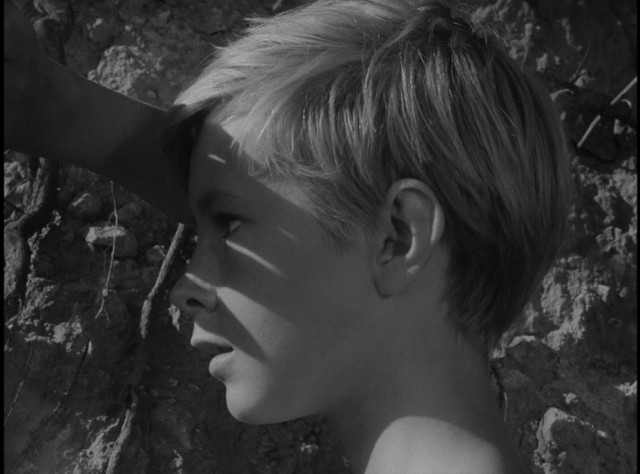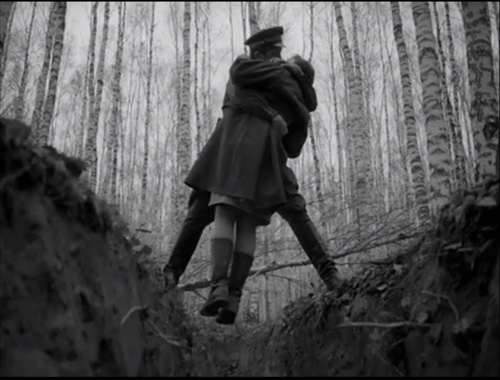IVAN’S CHILDHOOD (MY NAME IS IVAN) (Andrei Tarkovsky, 1979)
Museum of Arts & Design
2 Columbus Circle at 58th St. & Eighth Ave.
Friday, July 24, $10, 7:00
Series continues Friday nights through August 28
212-299-7777
madmuseum.org
 In his 1986 book Sculpting in Time, Soviet auteur Andrei Tarkovsky wrote, “I have to admit that before the appearance of my first full-length work, Ivan’s Childhood, I did not feel that I was a director, nor did the cinema have any inkling of my existence.” That was certainly not the case after the film was released, as it won the Golden Lion at Venice, earned the praises of Jean-Paul Sartre, and went on to have a profound impact on global cinema. Based on a 1957 short story by Vladimir Bogomolov, Ivan’s Childhood is a magnificent tale of a fearless twelve-year-old boy (Nikolai Burlyayev) who spies for the Soviets during World War II. But for all of his outward toughness, he is still a child who dreams of another, safer life, wrapped in the welcoming arms of his dead mother (Irma Raush, Tarkovsky’s first wife). Shot in black-and-white by Vadim Yusov, the film opens with Ivan standing behind a large spiderweb, as if being captured in this fateful world is inevitable. The smiling, clean Ivan admires flora and fauna as he floats through the air, but when he comes back to the ground, he sees torn roots that remind him of the family he’s lost to the war and is eventually woken up from this dream and finds himself in the middle of a vast, burned-out landscape littered with death. He ultimately meets up with Capt. Kholin (Valentin Zubkov), Lt. Galtsev (Yevgeni Zharikov), Cpl. Katasonov (Stepan Krylov), and Lt. Col. Gryaznov (Nikolai Grinko) in a bunker, where the men decide that it is best for Ivan to go to the state military academy instead of continuing his dangerous reconnaissance missions. But Ivan, whose face is no longer clean but will seemingly be dirty forever, insists that he belongs with them, fighting the Germans. Of course, war is no place for a child, but there is no child quite like Ivan.
In his 1986 book Sculpting in Time, Soviet auteur Andrei Tarkovsky wrote, “I have to admit that before the appearance of my first full-length work, Ivan’s Childhood, I did not feel that I was a director, nor did the cinema have any inkling of my existence.” That was certainly not the case after the film was released, as it won the Golden Lion at Venice, earned the praises of Jean-Paul Sartre, and went on to have a profound impact on global cinema. Based on a 1957 short story by Vladimir Bogomolov, Ivan’s Childhood is a magnificent tale of a fearless twelve-year-old boy (Nikolai Burlyayev) who spies for the Soviets during World War II. But for all of his outward toughness, he is still a child who dreams of another, safer life, wrapped in the welcoming arms of his dead mother (Irma Raush, Tarkovsky’s first wife). Shot in black-and-white by Vadim Yusov, the film opens with Ivan standing behind a large spiderweb, as if being captured in this fateful world is inevitable. The smiling, clean Ivan admires flora and fauna as he floats through the air, but when he comes back to the ground, he sees torn roots that remind him of the family he’s lost to the war and is eventually woken up from this dream and finds himself in the middle of a vast, burned-out landscape littered with death. He ultimately meets up with Capt. Kholin (Valentin Zubkov), Lt. Galtsev (Yevgeni Zharikov), Cpl. Katasonov (Stepan Krylov), and Lt. Col. Gryaznov (Nikolai Grinko) in a bunker, where the men decide that it is best for Ivan to go to the state military academy instead of continuing his dangerous reconnaissance missions. But Ivan, whose face is no longer clean but will seemingly be dirty forever, insists that he belongs with them, fighting the Germans. Of course, war is no place for a child, but there is no child quite like Ivan.
The first full-length masterpiece of Tarkovsky’s short but brilliant career — he made seven films, in addition to the wonderful short The Steamroller and the Violin, which he wrote with Andrei Konchalovsky, before dying of cancer in 1986 at the age of fifty-four — Ivan’s Childhood is filled with unforgettable shots and poignant vignettes that establish the horrors of war and its effects on the Soviet Union. At one point, Ivan runs away and encounters an old man (Dmitri Milyutenko) pining for his wife as he cowers behind a rickety door in the open air, where his house used to be. In one of the film’s most famous and influential scenes, Capt. Kholin pursues a nurse, Masha (Valentina Malyavina), through a field of white birch trees; he ultimately catches and kisses her, holding her over a trench, his feet on either side of the narrow ditch, her feet dangling in the air, the birches rising in the distance behind him, a breathtaking image that is as ominous as it is beautiful. Later, Ivan feels trapped in a dark room; holding a flashlight and a knife, he rings an alarm bell, then cowers in tears, shown in silhouette, as bombings begin. Soon he is dreaming of happily sharing an apple with a young girl in the rain, the background shown in negative, the symbolism evoking potential tragedy as the girl grows increasingly sadder. Ivan might represent the future of the Soviet Union, but he is experiencing a childhood that no one should, surrounded by death and doom and devastation, his fate inevitable. All four of his dreams involve water, a metaphor for life, but he is drowning in memories (based on Tarkovsky’s own) that do him no good anymore. Tarkovsky made Ivan’s Childhood right out of film school, adapting a screenplay written by Mikhail Papava and working with a tight budget and deadline. Yet he, composer Vyacheslav Ovchinikov, set designer Evgeny Chemyayev, and Yusov were able to produce a spectacular film, a deeply psychological exploration of the end of innocence in the midst of war. “To be honest, in making my first film I had another objective: to establish whether or not I had it in me to be a director,” Tarkovsky wrote in Sculpting in Time. “In order to come to a definite conclusion I left the reins slack, as it were. I tried not to hold myself back. If the film turns out well, I thought, then I’ll have the right to work in the cinema. Ivan’s Childhood was therefore specially important. It was my qualifying examination.” It was also an unqualified success, leading to one of the great, albeit too brief, careers in cinema.
Ivan’s Childhood is screening July 24 at 7:00 as part of the the Museum of Arts & Design film series “Andrei Tarkovsky, Sculpting in Time,” which runs Friday nights through August 28 and includes all seven of Tarkovsky’s masterpieces (Solaris, Stalker, Ivan’s Childhood, Andrei Rublev, The Mirror, Nostalghia, The Sacrifice) before concluding with the behind-the-scenes documentary Directed by Andrei Tarkovsky. Tarkovsky was a superior craftsman whose cinematic oeuvre is filled with poetry and wonder, mystery and self-examination, exploring life and death, the past, the present, and the future, incorporating mesmerizing sound and visuals in telling complex stories like one else before or since.

